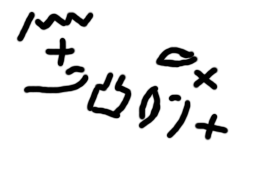Alphabet
Alphabet refers to a standardized set of letters or symbols used in writing to represent the basic sounds of a language. Alphabets are a key component of written communication and have evolved over thousands of years, with each language developing its own unique set of characters and rules for usage. The concept of an alphabet is central to the study of linguistics, the history of writing, and education, particularly in the realms of literacy and language learning.
History[edit | edit source]
The history of alphabets begins with the ancient civilizations of the Near East, around the 2nd millennium BCE. The earliest known alphabet is the Proto-Sinaitic script, which evolved into the Phoenician alphabet. The Phoenician alphabet is significant because it was widely adopted by other cultures and led to the development of several major alphabetic systems, including the Greek, Hebrew, and Aramaic alphabets. The Greek alphabet introduced vowels, a major advancement in the representation of speech sounds.
From the Greek alphabet, the Latin alphabet emerged, which is the most widely used alphabetic script in the world today, forming the basis of the alphabets used in most European languages, as well as many others globally. Other important alphabetic systems include the Cyrillic alphabet, used for Russian and several other Slavic and non-Slavic languages, and the Arabic alphabet, central to many languages of the Middle East and North Africa.
Types of Alphabets[edit | edit source]
Alphabets can be broadly categorized into two types: abjads and alphabets. Abjads, also known as consonantal alphabets, include scripts like the Arabic and Hebrew alphabets, where letters primarily represent consonants, leaving most vowels unnotated or indicated by diacritical marks. True alphabets, on the other hand, include both consonants and vowels as equal characters. The Latin, Cyrillic, and Greek alphabets are examples of true alphabets.
Function and Use[edit | edit source]
The primary function of an alphabet is to provide a set of symbols that can be used to represent the phonemic structure of a language as accurately and efficiently as possible. This allows for the clear and consistent written communication of ideas, historical records, literature, and more. Literacy, the ability to read and write, is deeply tied to the knowledge of a language's alphabet and its rules of usage.
In education, learning the alphabet is often the first step in learning to read and write in a given language. This process involves not only memorizing the order and shape of the letters but also understanding the sounds they represent and how they combine to form words.
Cultural Significance[edit | edit source]
Alphabets hold significant cultural importance and are often seen as symbols of national identity and heritage. For example, the adoption of the Latin alphabet by various Slavic nations in the 19th and 20th centuries was a key part of their national awakening and cultural development. Similarly, efforts to preserve endangered languages often involve the creation or standardization of alphabets to facilitate the documentation and teaching of these languages.
See Also[edit | edit source]
This article is a linguistics stub. You can help WikiMD by expanding it!
Transform your life with W8MD's budget GLP1 injections from $125
W8MD offers a medical weight loss program NYC and a clinic to lose weight in Philadelphia. Our W8MD's physician supervised medical weight loss centers in NYC provides expert medical guidance, and offers telemedicine options for convenience.
Why choose W8MD?
- Comprehensive care with FDA-approved weight loss medications including:
- loss injections in NYC both generic and brand names:
- weight loss medications including Phentermine, Qsymia, Diethylpropion etc.
- Accept most insurances for visits or discounted self pay cost.
- Generic weight loss injections starting from just $125.00 for the starting dose
- In person weight loss NYC and telemedicine medical weight loss options in New York city available
- Budget GLP1 weight loss injections in NYC starting from $125.00 biweekly with insurance!
Book Your Appointment
Start your NYC weight loss journey today at our NYC medical weight loss, and Philadelphia medical weight loss Call (718)946-5500 for NY and 215 676 2334 for PA
Search WikiMD
Ad.Tired of being Overweight? Try W8MD's NYC physician weight loss.
Semaglutide (Ozempic / Wegovy and Tirzepatide (Mounjaro / Zepbound) available. Call 718 946 5500.
Advertise on WikiMD
|
WikiMD's Wellness Encyclopedia |
| Let Food Be Thy Medicine Medicine Thy Food - Hippocrates |
Translate this page: - East Asian
中文,
日本,
한국어,
South Asian
हिन्दी,
தமிழ்,
తెలుగు,
Urdu,
ಕನ್ನಡ,
Southeast Asian
Indonesian,
Vietnamese,
Thai,
မြန်မာဘာသာ,
বাংলা
European
español,
Deutsch,
français,
Greek,
português do Brasil,
polski,
română,
русский,
Nederlands,
norsk,
svenska,
suomi,
Italian
Middle Eastern & African
عربى,
Turkish,
Persian,
Hebrew,
Afrikaans,
isiZulu,
Kiswahili,
Other
Bulgarian,
Hungarian,
Czech,
Swedish,
മലയാളം,
मराठी,
ਪੰਜਾਬੀ,
ગુજરાતી,
Portuguese,
Ukrainian
Medical Disclaimer: WikiMD is not a substitute for professional medical advice. The information on WikiMD is provided as an information resource only, may be incorrect, outdated or misleading, and is not to be used or relied on for any diagnostic or treatment purposes. Please consult your health care provider before making any healthcare decisions or for guidance about a specific medical condition. WikiMD expressly disclaims responsibility, and shall have no liability, for any damages, loss, injury, or liability whatsoever suffered as a result of your reliance on the information contained in this site. By visiting this site you agree to the foregoing terms and conditions, which may from time to time be changed or supplemented by WikiMD. If you do not agree to the foregoing terms and conditions, you should not enter or use this site. See full disclaimer.
Credits:Most images are courtesy of Wikimedia commons, and templates, categories Wikipedia, licensed under CC BY SA or similar.
Contributors: Prab R. Tumpati, MD







